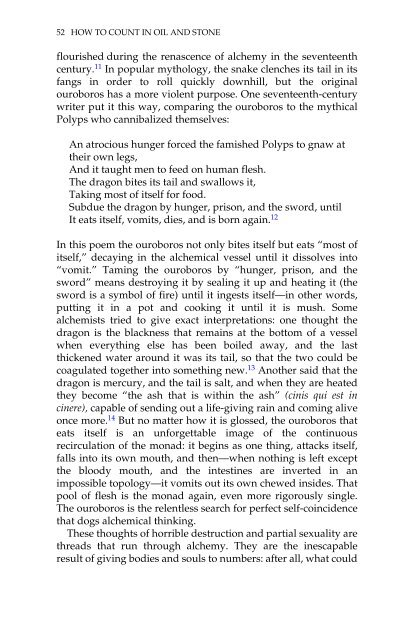What Painting Is: How to Think about Oil Painting ... - Victoria Vesna
What Painting Is: How to Think about Oil Painting ... - Victoria Vesna
What Painting Is: How to Think about Oil Painting ... - Victoria Vesna
Create successful ePaper yourself
Turn your PDF publications into a flip-book with our unique Google optimized e-Paper software.
52 HOW TO COUNT IN OIL AND STONE<br />
flourished during the renascence of alchemy in the seventeenth<br />
century. 11 In popular mythology, the snake clenches its tail in its<br />
fangs in order <strong>to</strong> roll quickly downhill, but the original<br />
ouroboros has a more violent purpose. One seventeenth-century<br />
writer put it this way, comparing the ouroboros <strong>to</strong> the mythical<br />
Polyps who cannibalized themselves:<br />
An atrocious hunger forced the famished Polyps <strong>to</strong> gnaw at<br />
their own legs,<br />
And it taught men <strong>to</strong> feed on human flesh.<br />
The dragon bites its tail and swallows it,<br />
Taking most of itself for food.<br />
Subdue the dragon by hunger, prison, and the sword, until<br />
It eats itself, vomits, dies, and is born again. 12<br />
In this poem the ouroboros not only bites itself but eats “most of<br />
itself,” decaying in the alchemical vessel until it dissolves in<strong>to</strong><br />
“vomit.” Taming the ouroboros by “hunger, prison, and the<br />
sword” means destroying it by sealing it up and heating it (the<br />
sword is a symbol of fire) until it ingests itself—in other words,<br />
putting it in a pot and cooking it until it is mush. Some<br />
alchemists tried <strong>to</strong> give exact interpretations: one thought the<br />
dragon is the blackness that remains at the bot<strong>to</strong>m of a vessel<br />
when everything else has been boiled away, and the last<br />
thickened water around it was its tail, so that the two could be<br />
coagulated <strong>to</strong>gether in<strong>to</strong> something new. 13 Another said that the<br />
dragon is mercury, and the tail is salt, and when they are heated<br />
they become “the ash that is within the ash” (cinis qui est in<br />
cinere), capable of sending out a life-giving rain and coming alive<br />
once more. 14 But no matter how it is glossed, the ouroboros that<br />
eats itself is an unforgettable image of the continuous<br />
recirculation of the monad: it begins as one thing, attacks itself,<br />
falls in<strong>to</strong> its own mouth, and then—when nothing is left except<br />
the bloody mouth, and the intestines are inverted in an<br />
impossible <strong>to</strong>pology—it vomits out its own chewed insides. That<br />
pool of flesh is the monad again, even more rigorously single.<br />
The ouroboros is the relentless search for perfect self-coincidence<br />
that dogs alchemical thinking.<br />
These thoughts of horrible destruction and partial sexuality are<br />
threads that run through alchemy. They are the inescapable<br />
result of giving bodies and souls <strong>to</strong> numbers: after all, what could


